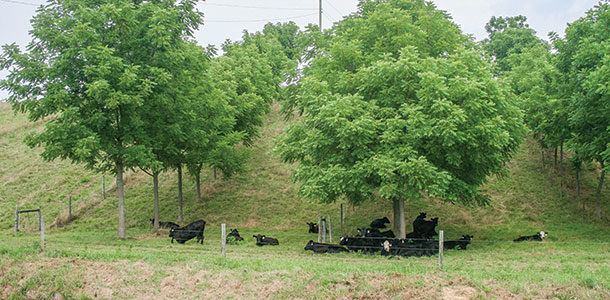Planting trees to create silvopastures may not have the immediacy of thinning, but it can have several advantages. In contrast to thinning, which typically is a take-what-you-get proposition, planting gives managers the opportunity to select preferred tree species for any of several possible uses.
Planting also allows planning for or adaptation to existing infrastructure. This facilitates farm operations and provides opportunity to create desired interactions among trees, forages and livestock.
Planning for silvopastures
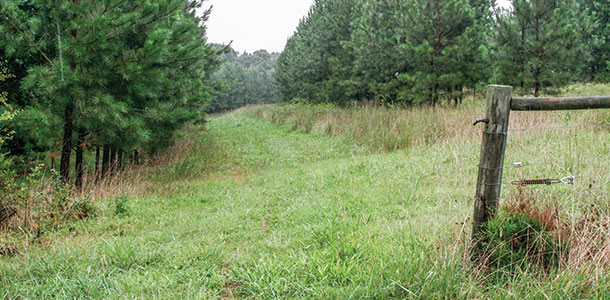
Anyone wanting to implement silvopastures should “build a team and plan, plan, plan.”
Seeking advice from those who have implemented silvopastures, working with others who have expertise in trees, forages and livestock, and getting feedback from those who contribute to the farm operations (e.g., custom applicators) can save time, money and frustration.
Consideration, too, must be given to layout, compatibility with forage species, appropriate protection from livestock and equipment, and long-term management needs.
Tree selection
Tree selection is critical because, as one Virginia forester says, “You can grow almost any tree almost anywhere for a period of time – but not necessarily well.” As much as possible, trees should complement the farm operation, not compete with it.
Typical attributes for tree selection include marketable timber, high-quality wood, rapid growth, deep-rooted morphology to reduce competition with forages, open canopy to allow more light to the forage understory, early leaf-out and late leaf-drop dates, drought tolerance, production of additional products (e.g., nuts, fodders, pine straw) and provision of environmental conservation services.
Other important criteria include cost, labor, site suitability, resources required for establishment and management, and the land’s tenure constraints.
Because no tree species will meet all of these criteria, selection should be a “best match” with the producer’s goals and resources. For many, trees will first be part of an animal comfort strategy – to relieve heat stress in summer or to provide windbreaks and shelter in winter – or as secondary feed sources.
Others may be as interested in tree products, whether marketed as commodities (e.g., pine straw or greenery, nuts or fruits) or as value-added goods (such as wreaths, ciders, acorn-fattened or apple-fattened hogs).
Creating wildlife habitat for hunting leases is another common goal. Of course, these aims are all academic if on-the-ground resources such as soils or climate aren’t amenable to a producer’s trees of interest.
Combining different tree species may be a useful practice that can serve multiple functions. Planting rows of conifers on either side of hardwood timber trees can provide a windbreak and simultaneously force the hardwoods to adapt a straighter and less spreading growth form, thus reducing pruning.
The conifers may be harvested for pulpwood, providing much earlier returns to the system than possible with hardwoods alone.
Mixed plantings also may be useful where trees have complementary or off-setting features. For example, black walnut trees have long rotation times and release compounds that are detrimental to legumes.
Thus, planting several black locusts between the walnut “leave” trees within rows could offset the negative effects to clovers because the locusts fix nitrogen and reach harvesting size at an earlier age.
Layout
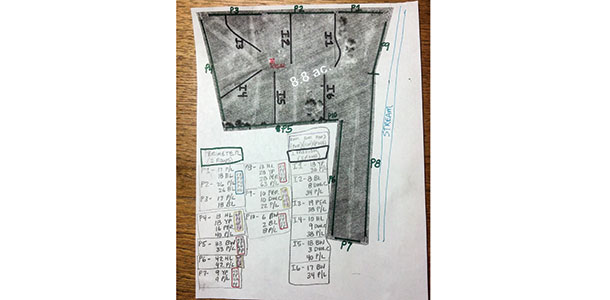
Planning the silvopasture layout should not be underestimated. Tree planting density and spatial arrangements will vary based on the amount of shade the species casts or the water required.
Layout also should consider prevailing winds, animal movement, infrastructural needs and aesthetic appeal.
Clumped arrangements can be visually appealing and beneficial for some tree species, but most plantings are laid out in rows. Thus, row orientation becomes an important factor for optimizing light to the forage understory, with north-south rows preferred at mid-to-higher latitudes, and east-west orientations favored at low latitudes.
However, this must be balanced with other considerations. For instance, layout must accommodate rotational grazing and appropriate feeder and waterer placements, which are essential parts of good silvopasture management. And to avoid serious headaches, designs also must account for future tree growth and leave room to move or turn around equipment in the field.
Vegetation control
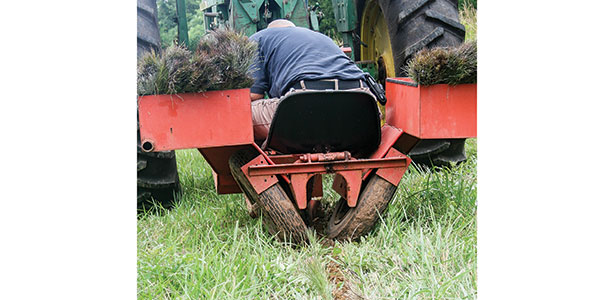
Killing and removing existing vegetation typically are considered essential steps for tree establishment, although this is somewhat species-dependent.
For example, pines such as slash and loblolly are fairly robust and may tolerate planting into ground cover; however, shortleaf and Monterey will not fare as well. Even with tolerant species, the release from competition will speed tree growth.
For those averse to herbicides, tillage can be used to kill and break up existing vegetation at establishment. Intense grazing pressure may also be used to weaken forage stands.
After planting, mats, mulches or judicious mowing or grazing can be used to suppress vegetation, but herbicides generally have greatest effect and economy for vegetation control.
Tree protection and management
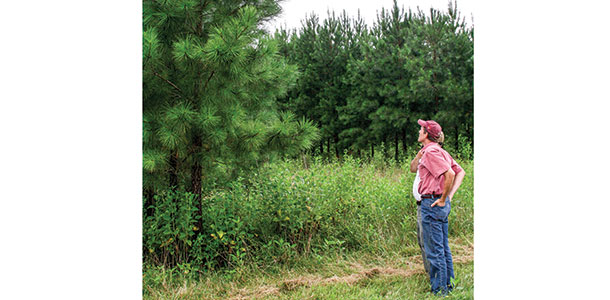
Tubes rarely are used to protect conifer seedlings. Given low costs of the seedlings, high tree density per acre and lower levels of predation, this would seem uneconomical in most cases. In contrast, tubing a hardwood tree typically is standard practice.
Whether this truly is needed likely depends on predation pressure, but risk of herbivory by rodents, deer or livestock typically is high, especially with low-density plantings.
Once the trees grow out of the tubes, a single hot wire can be positioned about 3 feet from the tree row, allowing cows to graze near the tree but not to browse the tree itself. A three-dimensional fence may be adequate to keep deer at bay.
Keeping the wires high enough to allow sheep or calf access also can be effective for vegetation management. Of course, if fencing is not an option, it may be best to make hay in the alleys until the trees are of adequate size to integrate with livestock.
Consider livestock class, age and condition as well as tree types when making protection decisions. Some studies have shown that mama cows won’t browse slash-pine seedlings if they have adequate forage, and trampling losses may be offset by the savings from not protecting the trees.
However, young steers have been observed making a game of pulling newly planted pine seedlings from the ground, and bulls will “walk down” sizeable pine trees to get a belly rub.
Some additional considerations
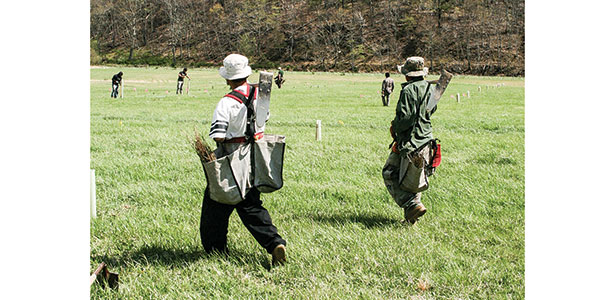
Silvosystems are dynamic and change (and will require input) over time. Maintaining adequate light to the forage understory may require thinning or pruning – but this can have other benefits.
For instance, trees with clean boles can have substantially greater timber values when premiums are available for high-quality logs, and removing small limbs can be done fairly readily during the off season.
Although economic analyses are limited, greater returns generally accrue to silvopasture systems that incorporate routine tree maintenance.
Given the state of timber economics, producers looking to make large returns from growing a couple of acres of average-quality timber trees may face disappointment.
However, even small plantings offer opportunity to improve animal comfort and performance, protect environmental resources and create more appealing landscapes while diversifying farm income streams.
The big challenge for implementation is a willingness to manage complexity and to think in time-period scales not common in the agricultural community. FG
John Fike is a forage, livestock and biofuels specialist with Virginia Tech and acknowledges the dedication of a silvopasture team that included Miller Adams, Jim Burger, J.B. Daniel, Adam Downing, Jason Fisher, Greg Frey, Tim Mize, John Munsell and Chris Teutsch.
PHOTOS
PHOTO 1: Both soft and hardwood species are suitable for silvopastures, and a multitude of trees and configurations can be utilized. “Warm-season” trees such as locusts, walnuts and members of the hickory family leaf out after the initial flush of cool-season forage growth, thus reducing competition with forages in spring and buffering forages and livestock from high temperatures in summer. Leaves from such trees also degrade more readily than heavy leaves of oaks or maples. Trees in this 2011 picture were thinned by half in 2012. Conifers are well suited to high-density plantings with wide alleys. Photo courtesy of John Fike.
PHOTO 2: At this site, fescue or switchgrass plus lespedeza are grown in the alleys, providing excellent habitat for quail and other wildlife. Photo courtesy of Gabriel Pent.
PHOTO 3: A good map of the farm or targeted fields can greatly aid silvopasture planning. Knowing soils and boundary dimensions will be helpful for tree selection and placement. GPS systems can be useful for the layout, but in this case, the farmer – a pilot and IBM engineer – used crayons to mark a blow-up of the farm before graduating to permanent markers. Photo courtesy of Gabriel Pent.
Permanent fences placed alongside the tree rows for protection also facilitate rotations, making grazing management easier. Photo courtesy of Gabriel Pent.
PHOTO 4: A mechanical tree planter may be best for establishing long rows of conifers at high density. These trees were planted at 4-feet spacing within rows, 8-feet spacing between rows, with 60-feet alleys. Photo courtesy of John Fike, Todd Groh and Todd Repass.
PHOTO 5: Growth often is more rapid in pastures due to greater fertility resources. These 11-year-old loblolly pines were about 15 feet tall. Photo courtesy of Gabriel Pent
PHOTO 6: Tillage or spraying can be used to reduce vegetative competition for new plantings. Flagging is helpful to indicate which and how many trees go in a row. Several methods can be used to plant trees. Large-scale plantings requiring tubes can be placed by hand with commercial crews at relatively low cost. Photo courtesy of John Fike, Todd Groh and Todd Repass.
